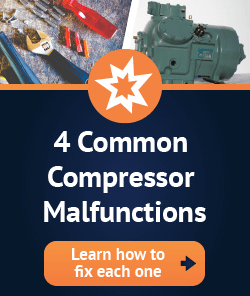The HVAC/R compressor is one of the most critical components in any heating, ventilation, and air conditioning or Refrigeration (HVAC/R) system. Without it, the entire system would be unable to perform its fundamental task of regulating indoor temperatures. HVAC/R compressors facilitate the movement of refrigerant, ensuring the proper absorption and release of heat, which is at the core of how an air conditioning system operates. Let’s explore the function of an HVAC/R compressor, how it integrates into the cooling process, and the different types of compressors commonly used in commercial systems.
The Role of Refrigerant in Heat Transfer
To understand how HVAC/R commercial compressors work, it’s important to first grasp the role refrigerant plays in the cooling process. Contrary to common belief, refrigerant doesn’t just cool air on its own. Its primary function is to transfer heat from one area to another through a process called heat exchange. As air passes over the evaporator coils within the HVAC/R system, the refrigerant inside these coils absorbs heat from the air. This heat is then carried away from the indoor space and expelled outside. As a result, the air that recirculates inside the building is much cooler.
This cooling effect occurs not because cold air is generated but because heat is removed. It’s the job of the refrigerant to absorb indoor heat and release it outdoors, and the HVAC/R compressor is essential for making this transfer possible.
How the HVAC/R Compressor Functions
The compressor acts as the driving force behind the refrigeration cycle. Its primary job is to compress the refrigerant, turning it into a high-pressure, high-temperature gas. This step is crucial because it raises the temperature of the refrigerant above the outside air, allowing for the efficient transfer of heat to the outdoors. The process starts with the refrigerant absorbing heat from the indoor air as it passes through the evaporator coils. The refrigerant, now in a low-pressure gaseous state, enters the compressor.
Inside the compressor, the gas is rapidly compressed, significantly increasing its temperature and pressure. This hot, pressurized refrigerant is then pumped through the condenser coils, where outdoor air blows across the coils to dissipate the heat. Once the heat is released, the refrigerant cools and turns back into a liquid. It then flows back inside to start the cycle over again by absorbing more heat from the indoor air.
Without this compression stage, the refrigerant wouldn’t be hot enough to release its heat outdoors, and the cooling cycle would break down. Essentially, the compressor is the heart of the HVAC/R system, enabling it to continuously remove heat and regulate indoor temperatures.
Types of Compressors and Their Operation
Commercial HVAC/R systems use different types of commercial compressors, each with unique characteristics that impact performance, efficiency, and cost. Understanding these variations is important for both HVAC/R technicians and building owners looking to optimize system performance.
- Reciprocating Compressors: These compressors operate similarly to a car engine. Inside, a piston compresses the refrigerant gas by drawing it into a chamber and then forcing it out at high pressure. These compressors are highly reliable but can be less efficient compared to other types due to the mechanical complexity of the piston system.
- Scroll Compressors: More commonly used in modern HVAC/R systems, scroll compressors offer better efficiency and quieter operation. They consist of two spiral-shaped components—one stationary and one orbiting. As the orbiting spiral moves, it compresses the refrigerant into smaller spaces, gradually increasing its pressure. Scroll compressors are highly efficient and are well-suited for commercial applications where consistent performance is key.
- Screw Compressors: Screw compressors are another high-efficiency option, particularly for large-scale commercial and industrial HVAC/R systems. These compressors use two interlocking screws to compress the refrigerant as it moves through the system. This continuous compression process leads to highly efficient operation, especially in applications where the HVAC/R system needs to run constantly. Screw compressors tend to be more expensive upfront but provide cost savings in the long run due to their efficiency.
The Importance of Maintaining Your Compressor
Given the crucial role that the compressor plays in the operation of an HVAC/R system, regular maintenance is vital to ensure optimal performance. If the compressor isn’t functioning properly, the entire HVAC/R system will struggle to regulate indoor temperatures effectively. Some common issues with compressors include overheating, electrical failures, and mechanical wear over time.
One of the most telling signs of a compressor problem is if the system isn’t cooling the building as efficiently as it should. If the refrigerant isn’t reaching the right pressure levels, the heat transfer process becomes less effective, leading to increased energy consumption and uneven cooling. In such cases, it’s important to have a professional HVAC technician inspect the system and determine whether repair or replacement of the compressor is necessary.
For commercial HVAC/R systems, investing in a high-quality commercial remanufactured compressor is crucial to ensuring the long-term efficiency and reliability of the system. While upfront costs may be higher for more efficient compressor models like scroll or screw remanufactured compressors, the energy savings over time can make them a cost-effective choice for businesses looking to manage their operational expenses.
The Core of HVAC/R Performance
The HVAC/R commercial compressor plays an indispensable role in regulating indoor temperatures and ensuring the efficiency of the overall system. Its ability to convert refrigerant from a low-pressure gas to a high-pressure gas allows the refrigerant to effectively transfer heat out of the building, making it possible for air conditioning systems to cool indoor spaces. Understanding how the compressor works and choosing the right type for your commercial system—whether it’s a reciprocating, scroll, or screw compressor—can have a significant impact on the performance and longevity of your HVAC/R system. Regular maintenance is essential to keep the compressor operating efficiently and to prevent costly breakdowns, ensuring comfort and energy savings for years to come.












